As a dog owner, you seek the utmost for your pet, including a balanced diet. Grain-free dog food has become increasingly popular, seen as a healthier choice by many. But does it truly benefit our canine friends?
Let’s explore the facts behind this trend.
A recent study found that 35% of Chewy shoppers choose grain-free dog food, leveraging free shipping deals. Proponents of grain-free diets claim it improves digestion, enhances skin and coat health, and lowers allergy risks. Yet, the FDA is probing a possible connection between grain-free diets and heart disease in dogs, sparking concerns among pet owners and vets.
Choosing the right dog food is crucial, considering your pet’s unique needs. Age, breed, size, and health status are key factors in determining the best diet. Many pet owners often wonder, “Is grain-free dog food better for dogs?” Grain-free dog foods vary in protein (27.8% to 38.3%) and carbs (18.6% to 49.3%), catering to various nutritional needs. Always consult your vet before altering your dog’s diet significantly.
Understanding Grain-Free Dog Food!
Grain-free dog food has become increasingly popular among pet owners. It offers a different diet option compared to traditional dog food. But what is grain-free dog food, and how does it differ from regular dog food?
What is Grain-Free Dog Food?
Grain-free dog food, as the name implies, does not include grains like wheat, corn, rice, or barley. Instead, it uses alternative carbs such as potatoes, peas, and lentils. These provide energy and fiber for your dog’s diet.
The concept behind grain-free dog food is to mimic a wolf’s diet. Wolves mainly eat meat, organs, and bones. Advocates believe grains are unnatural for dogs and may lead to health problems like allergies, digestive issues, and obesity.
Common Ingredients in Grain-Free Dog Food
Grain-free dog food typically lists high-quality protein sources. These include:
- Chicken
- Beef
- Fish (like salmon or whitefish)
- Lamb
- Turkey
- Duck
These proteins are often paired with alternative carbs like:
- Potatoes (white or sweet)
- Peas
- Lentils
- Chickpeas
- Tapioca
Grain-free dog foods also include fruits and vegetables. Examples are apples, blueberries, carrots, and spinach. These add essential vitamins, minerals, and antioxidants for your dog’s health and well-being.
The Rise of Grain-Free Dog Food!
In recent years, grain-free dog food has seen a significant increase in popularity. This surge is due to several factors, including the belief that it mimics a dog’s natural diet. Many pet owners believe grains can cause allergies or digestive issues in their dogs. Thus, they opt for grain-free alternatives.

Factors Contributing to the Popularity of Grain-Free Dog Food
The rise in awareness about nutrition’s role in a dog’s health has driven this trend. As organic and natural food trends for humans grow, so does the interest in similar options for dogs. Grain-free dog food is seen as healthier and more natural. It typically has more protein and fewer carbs than traditional dog food.
Marketing and Consumer Perception
The pet food industry has greatly influenced consumer perception, boosting grain-free dog food demand. Effective marketing highlights the diet’s potential benefits, such as better digestion and healthier skin. This has made grain-free dog food seem like a premium choice to health-conscious pet owners. They are willing to invest in what they believe is the best for their dogs.
Potential Benefits of Grain-Free Dog Food!
Grain-free dog food has seen a surge in popularity, thanks to its potential health benefits for our pets. Understanding the benefits of grain-free dog food can help you make an informed decision about your pet’s diet. Not every dog needs a grain-free diet, but some may find relief from grain elimination. Let’s dive into the advantages grain-free dog food may offer.
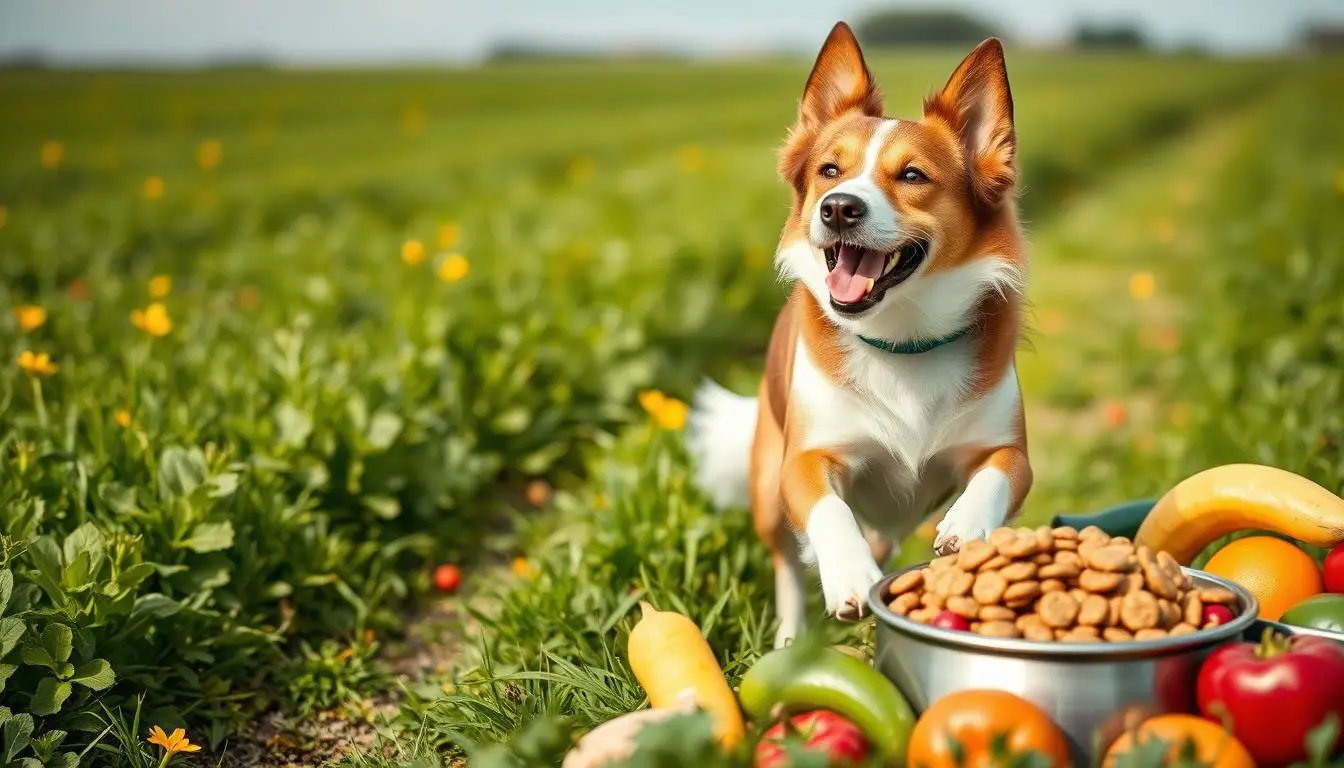
Addressing Food Allergies and Sensitivities
Pet owners often choose grain-free dog food to tackle food allergies or sensitivities. Some dogs react poorly to grains like wheat or corn, causing digestive problems, skin issues, or other health issues. By removing these grains, you might ease these symptoms and enhance your dog’s health.
Improved Digestion and Nutrient Absorption
Grain-free dog food typically has more protein and essential nutrients than traditional dog food. Without grains, it offers a more concentrated nutrient profile. This can improve digestion and nutrient absorption, which is great for dogs with sensitive stomachs or digestive problems.
Healthier Skin and Coat
Many grain-free dog foods include omega-3 fatty acids from fish or flaxseed. These fatty acids are vital for a healthy skin and coat. Adding grain-free dog food to your pet’s diet may lead to shinier, softer fur and less skin irritation or dryness. Yet, grain-free dog food isn’t right for every dog. Some dogs do well on grain-based diets. It’s crucial to consult with your vet to find the best diet for your pet. They can evaluate your dog’s needs and suggest a balanced diet that fulfills their nutritional requirements.
Controversies Surrounding Grain-Free Dog Food!
Grain-free dog foods have become increasingly popular, yet they are surrounded by controversy. Pet owners and veterinarians debate their safety. A major concern is their possible link to dilated cardiomyopathy (DCM) in dogs.

In 2018, the U.S. Food and Drug Administration (FDA) started investigating DCM in dogs eating grain-free diets. They found that certain breeds, like Golden Retrievers and Labrador Retrievers, were at higher risk. This finding sparked worries about the safety of grain-free dog foods.
Link to Dilated Cardiomyopathy (DCM) in Dogs
Dilated cardiomyopathy weakens the heart muscle, causing it to enlarge. This makes it hard for the heart to pump blood, leading to serious health issues. The FDA’s investigation suggested a link between grain-free diets and an increased DCM risk.
Lack of Scientific Evidence Supporting Grain-Free Diets
Despite marketing claims, there’s no solid scientific proof that grain-free diets are better than traditional dog foods. Veterinary nutritionists point out that grains can be nutritious for dogs when processed correctly. They argue that grains are not inherently bad for dogs. The debate over grain-free dog foods has prompted a reevaluation of their role in canine nutrition. Pet owners should talk to their vets before changing their dog’s diet. While grain-free diets might be good for some dogs, they’re not necessary for all.
Is Grain-Free Dog Food Better for Dogs?
Considering your dog’s nutrition, you might ponder if grain-free dog food is superior. The rise in grain-free diets for dogs prompts a closer look at their benefits over traditional options. The decision on grain-free dog food hinges on your dog’s individual needs and health. It’s not a one-size-fits-all solution. While beneficial for some, it’s not ideal for all dogs.
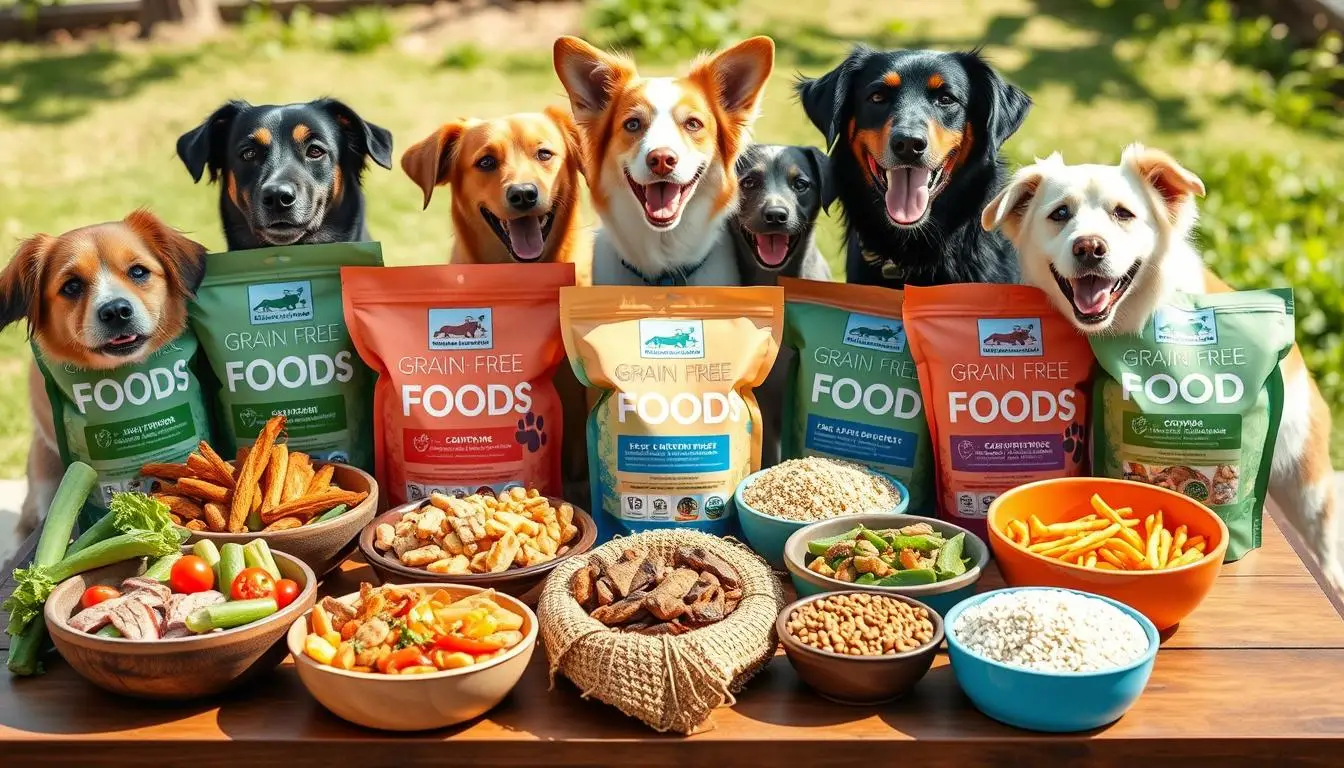
A report by the American Pet Products Association shows grain-free dog food’s popularity. In 2020, it made up 44% of U.S. dog food sales. This trend suggests a shift towards alternative diets. Yet, it’s vital to assess your dog’s specific needs before switching.
A study in the Journal of Animal Science indicates a 15% lower allergy risk in dogs on grain-free diets. This could be beneficial for dogs with food sensitivities or allergies. A grain-free diet might improve their health and well-being. A survey by a leading pet nutrition company found 72% of dog owners noticed better coat and skin health after switching to grain-free. If your dog has a dull coat or itchy skin, a grain-free diet could be beneficial.
Yet, not all dogs need a grain-free diet. Whole grains offer essential nutrients and fiber, crucial for a balanced diet. Always consult with your vet to see if a grain-free diet is right for your dog.
The Role of Grains in a Balanced Dog Diet!
Grains are crucial in a balanced diet for your furry friend. Despite the rise in grain-free dog food, whole grains offer significant nutritional value. They are essential for your dog’s health.
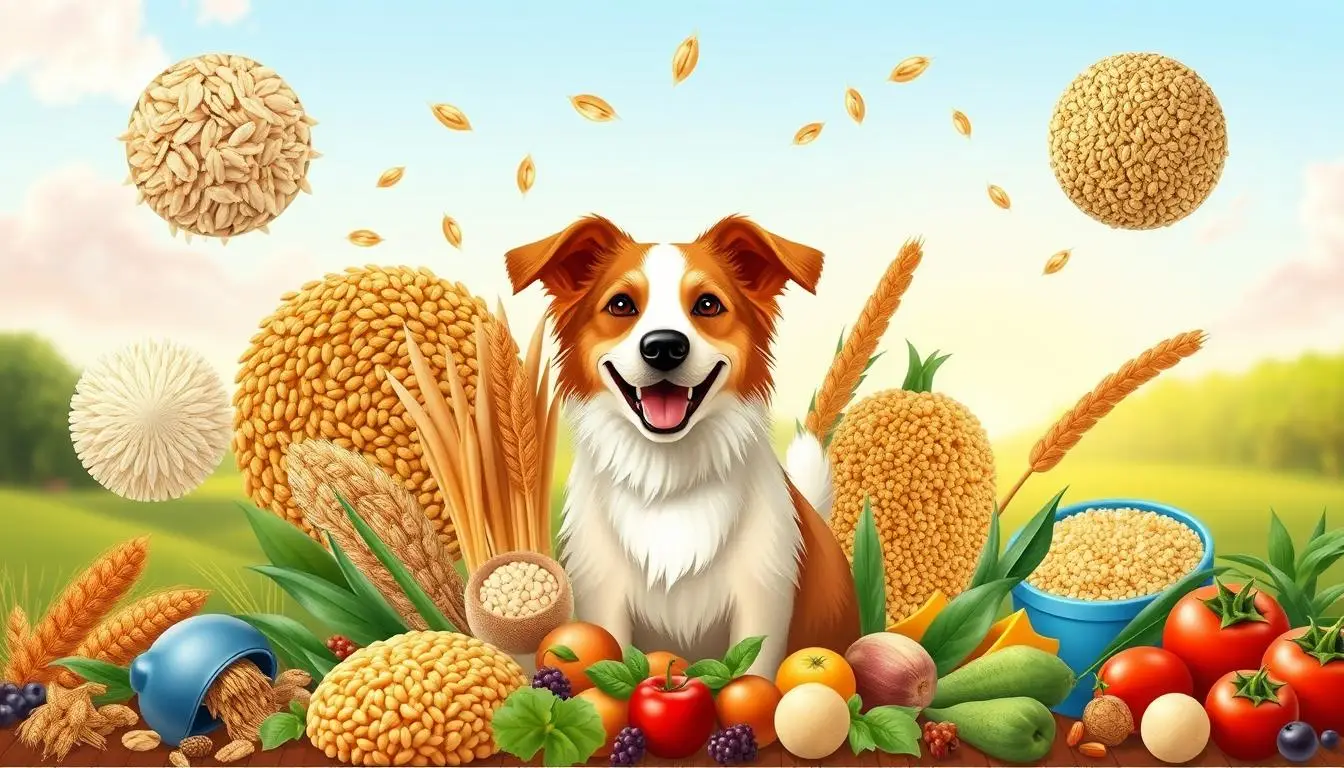
Nutritional Value of Whole Grains
Whole grains, like brown rice, oats, and barley, are rich in nutrients. They provide carbohydrates, which are vital for your dog’s energy. These grains also contain vitamins, minerals, and fiber, supporting various bodily functions. Fiber is key for a healthy digestive system. It aids in regular bowel movements, promotes beneficial gut bacteria, and keeps your dog full. Whole grains ensure your dog gets enough dietary fiber.
Grains as a Source of Essential Nutrients
Grains are more than just carbohydrates and fiber. They are a source of essential nutrients. For instance, brown rice is rich in B vitamins, supporting energy and nervous system functions. Oats, on the other hand, are packed with manganese, crucial for bone health and wound healing. However, understanding the health benefits of grain-free dog food is also important, as it can cater to dogs with specific dietary needs and sensitivities.
Choosing whole grains over refined ones is vital. Whole grains retain their nutrient-rich outer layer, offering a more complete nutritional profile. This is crucial for your dog’s health. While some dogs may react to certain grains, most can benefit from whole grains. Always consult with your vet to find the best diet for your dog.
Choosing the Right Dog Food!
Choosing the best dog food can be daunting, with so many options out there. As a responsible pet owner, it’s crucial to make a well-informed choice. This choice should meet your dog’s unique nutritional needs. When choosing the right dog food, several key factors should be taken into consideration.
Considering Your Dog’s Individual Needs
Every dog is unique, with different dietary needs based on age, size, breed, activity level, and health status. Puppies need a nutrient-rich diet to support their rapid growth and development. Senior dogs, on the other hand, may benefit from a formula that promotes joint health and maintains a healthy weight. Certain breeds may have specific nutritional needs, such as large breeds requiring a diet that promotes controlled growth to prevent joint issues. Tailoring your dog’s diet to their individual needs ensures they receive the optimal nutrition for their well-being.
Consulting with Your Veterinarian
When deciding on your dog’s diet, consulting with your veterinarian is crucial. They can offer personalized recommendations based on your dog’s health profile, including any allergies, sensitivities, or medical conditions. Your veterinarian can also guide you on the appropriate portion sizes and feeding frequency for your dog’s age and size. Regularly discussing your dog’s diet during check-ups allows your veterinarian to monitor their overall health and make necessary adjustments to their nutrition plan.
Reading and Understanding Dog Food Labels
To make an informed choice when selecting dog food, it’s essential to understand how to read and interpret dog food labels. Look for a statement from the Association of American Feed Control Officials (AAFCO) on the label, which ensures that the food meets the minimum nutritional requirements for your dog’s life stage. Pay attention to the ingredient list, which is ordered by weight, with the first few ingredients making up the majority of the diet. Opt for high-quality protein sources, such as named meat meals or whole meats, and avoid artificial preservatives, colors, and flavors. By familiarizing yourself with dog food labels, you can make more informed decisions about your dog’s nutrition.
Alternatives to Grain-Free Dog Food!
Exploring alternatives to grain-free dog food opens up several options for a balanced diet. These alternatives meet specific dietary needs, sensitivities, or preferences of your furry friend.
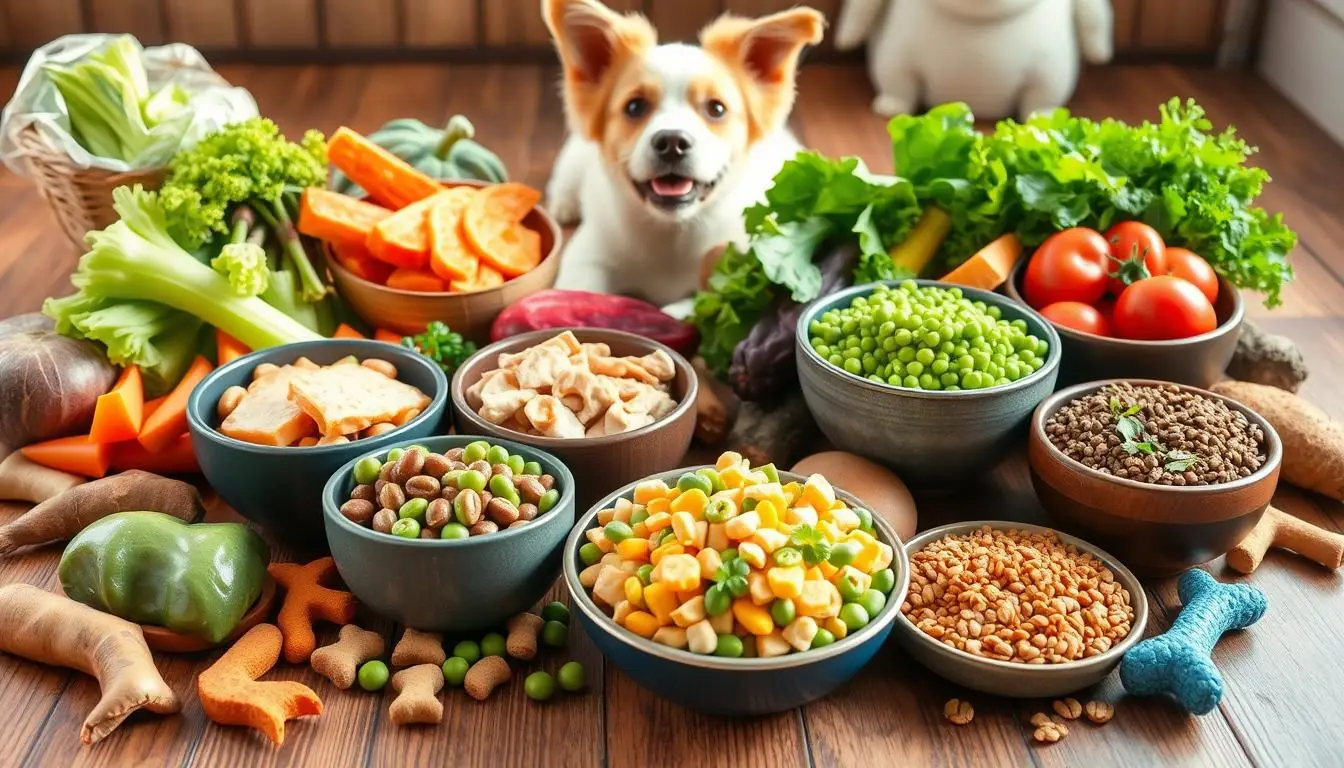
Limited Ingredient Diets
Limited ingredient diets focus on a single protein source and a few ingredients. They aim to reduce the risk of food allergies and sensitivities. This simplification helps identify and avoid potential triggers for digestive issues or skin irritations.
Single Protein Source Formulas
Single protein source formulas feature a single animal protein, like chicken, lamb, or fish. They cater to dogs with specific protein sensitivities or allergies. These formulas include digestible carbs and essential nutrients for a complete diet.
Rotation Feeding
Rotation feeding involves changing your dog’s food regularly. It introduces variety, preventing allergies or sensitivities. By exposing your dog to different proteins and nutrients, it ensures a balanced diet. Introduce new foods slowly to avoid digestive upset and consult your vet before starting. When looking for alternatives to grain-free dog food, consider your dog’s needs, age, breed, and health conditions. A vet’s advice is crucial for choosing a diet that supports your dog’s health and well-being.
Recommended Grain-Free Dry Dog Foods!
Transitioning your dog to a grain-free diet requires a high-quality, balanced food. The market offers several grain-free dry dog foods to meet this demand.
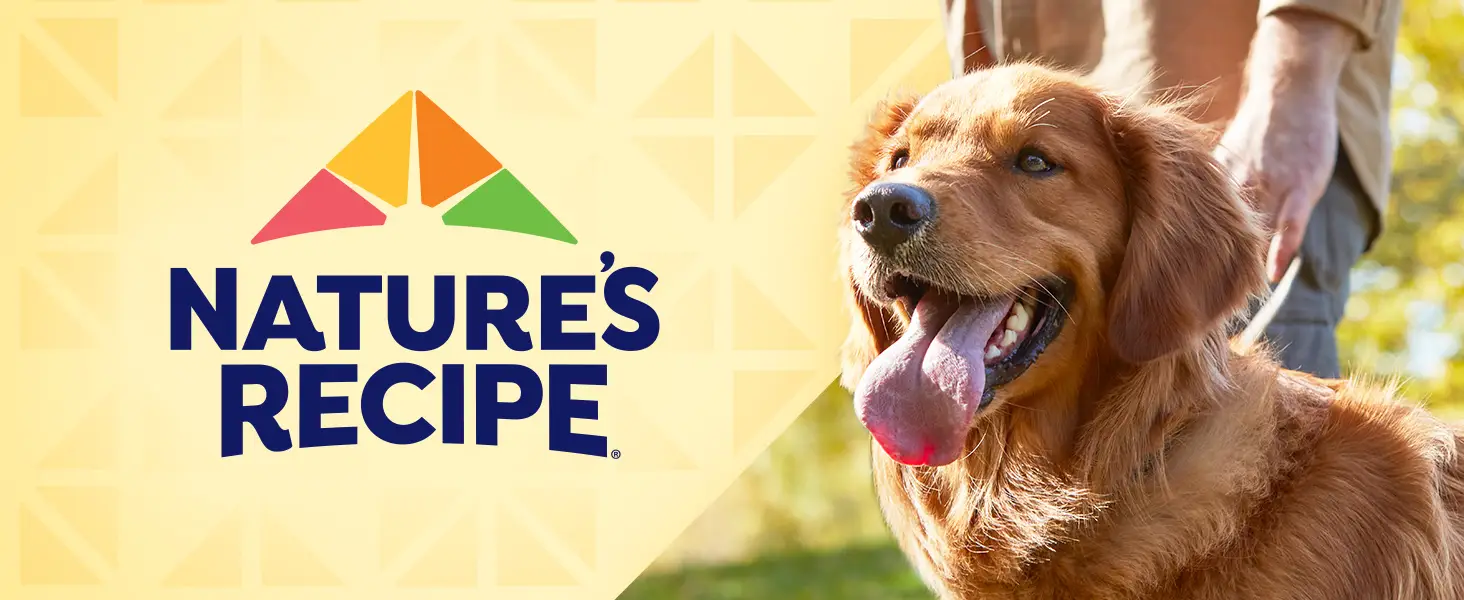
Nature’s Recipe Grain Free Salmon, Sweet Potato & Pumpkin Recipe is a top pick for pet owners seeking a nutritious diet for their dogs. It offers a balanced mix of protein, healthy carbohydrates, and fats, with salmon as the main protein. Salmon is rich in high-quality protein and omega-3 fatty acids. These nutrients promote a shiny coat, healthy skin, and support brain and joint health.
The inclusion of sweet potatoes and pumpkin adds easily digestible carbohydrates, ideal for sensitive stomachs. These ingredients are also rich in dietary fiber, aiding in digestive health by regulating bowel movements and promoting gut regularity. Pumpkin is known for soothing digestive issues like constipation or diarrhea.
This grain-free recipe is ideal for dogs with grain sensitivities or allergies. It avoids fillers like corn, wheat, and soy, focusing on natural, high-quality ingredients. These fuel your pup with the energy needed for an active lifestyle. Beyond the Salmon, Sweet Potato & Pumpkin Recipe, Nature’s Recipe offers other grain-free flavors. These cater to different preferences and dietary needs:
- Chicken, Sweet Potato & Pumpkin
- Lamb, Sweet Potato & Pumpkin
- Chicken & Venison
These recipes uphold the same quality commitment, focusing on lean proteins, digestible carbs, and excluding artificial additives.
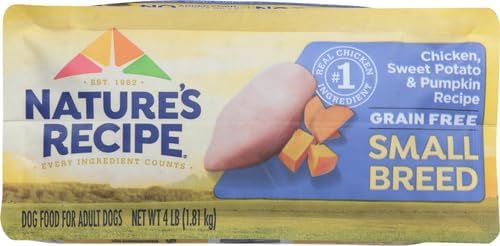
Got a small pup?
Nature’s Recipe Grain Free Small Breed Chicken, Sweet Potato & Pumpkin Recipe is perfect for small dogs. With real chicken as the first ingredient, it provides high-quality protein to support strong muscles. Sweet potatoes and pumpkin deliver easily digestible carbs and fiber, promoting healthy digestion and steady energy.
The small kibble size makes it easy to chew and digest, while the grain-free formula eliminates common allergens like corn, wheat, and soy. Plus, there are no artificial colors, flavors, or preservatives—just wholesome, natural nutrition for your little companion. Choosing Nature’s Recipe Grain Free means giving your dog a tasty, balanced meal. It supports healthy digestion, skin, and overall vitality. It’s a choice you can feel confident about.
Wellness CORE Grain-Free High-Protein Dry Dog Food
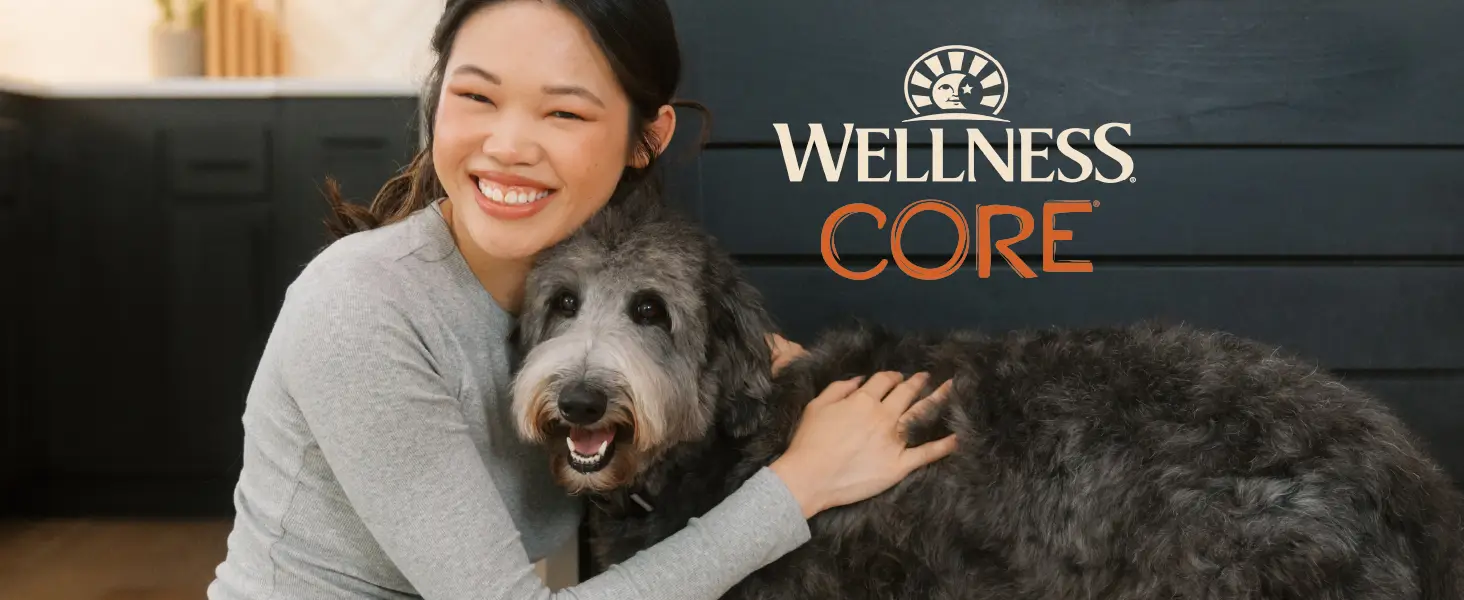
Wellness CORE Grain-Free High-Protein Dry Dog Food is a top choice for dogs that thrive on a protein-packed diet. This nutrient-rich formula supports lean muscle development, energy, and overall vitality. It’s ideal for active dogs, working breeds, or those needing extra protein.
The recipe features a delicious blend of chicken, turkey, and salmon. This offers high-quality protein and essential amino acids for strong muscles. It’s also grain-free, making it great for dogs with grain sensitivities or allergies. Instead of grains, it uses peas, potatoes, and flaxseed for energy, fiber, and essential fatty acids.
To cater to various taste preferences and dietary needs, Wellness CORE offers several flavors:
- Original Turkey & Chicken – A classic blend of lean poultry proteins for strong muscles.
- Ocean Whitefish, Herring & Salmon – A fish-based recipe rich in fatty acids to promote skin, coat, and brain health.
- Wild Game Duck, Lamb, Wild Boar & Rabbit – A unique, protein-rich blend that diversifies your dog’s diet.
- Reduced Fat Turkey & Chicken – A lower-fat, high-protein option ideal for weight management.
This formula also provides:
- Omega-3 and Omega-6 fatty acids for a healthy coat and skin.
- Probiotics and prebiotic fiber to support healthy digestion.
- Glucosamine and chondroitin for joint health, ideal for aging or active dogs.
- Antioxidants from superfoods like spinach, kale, and blueberries to boost immune function.
Wellness CORE Grain-Free is free from artificial colors, flavors, or preservatives. This ensures your pup gets only the best natural ingredients. With a variety of flavors, you can keep mealtime exciting while fueling your dog with the protein and nutrients they need to thrive. Choosing a grain-free dry dog food depends on your dog’s age, breed, and activity level. Always consult with your vet to ensure the best choice. Gradually introduce new foods to prevent digestive issues.
Myths and Facts About Grain-Free Dog Food!
The rise in grain-free dog food has fueled many myths and misconceptions. Many believe all grains are bad for dogs and should be avoided.
Yet, the reality is more complex.
While some dogs may react to certain grains, most can benefit from a diet rich in whole, high-quality grains. Another myth is that grain-free food is always best for dogs. The truth is, the right diet varies by dog. Some dogs do well on grain-free foods, while others need the nutrients and fiber from grains. Always consult with your vet to find the best diet for your dog.
Recent studies have highlighted potential health risks of grain-free diets. Veterinary cardiologists have seen more cases of Dilated Cardiomyopathy (DCM) in dogs on these diets. Ingredients like potatoes and legumes, common in these diets, may block taurine, leading to DCM.
It’s vital to separate fact from fiction when it comes to grain-free dog food. Grains are often essential for a balanced diet, offering vital nutrients and fiber. When picking a dog food, look for quality ingredients, get your vet’s advice, and consider your dog’s specific needs, not just the grain-free label.
The Future of Grain-Free Dog Food!
As a pet owner, you might wonder about the future of grain-free dog food. The pet food industry is evolving, with ongoing research and trends. This will likely change the landscape of grain-free diets in the coming years.
The organic natural pet foods market is valued at USD 12.71 billion in 2023. It’s expected to grow at a CAGR of 8.95% from 2024 to 2032. By then, it will reach USD 27.5 billion. This growth is driven by consumer preferences for organic and natural products. Pet owners now see their pets as family, focusing on quality and nutritional value in their food.
Ongoing Research and Studies
Researchers are still studying the long-term effects of grain-free diets on dog health. Some studies have linked these diets to dilated cardiomyopathy (DCM) in dogs. Yet, more research is needed to fully grasp the relationship between grain-free food and canine health. As new research comes in, pet food manufacturers may adjust their formulations to ensure our pets’ safety and well-being.
Evolving Pet Food Industry Trends
The pet food industry is evolving to meet pet owners’ changing demands. Key trends shaping the future of grain-free dog food include:
- A focus on sustainable and eco-friendly packaging, with an emphasis on recycle-ready materials and post-consumer recycled (PCR) content
- The rise of fresh and frozen pet food, which requires specialized packaging to maintain product integrity and safety
- The introduction of active and intelligent packaging solutions, such as thermochromic ink and oxygen scavenging technologies, to enhance product freshness and shelf life
As these trends evolve, you can expect new and innovative grain-free dog food options. These will cater to your pet’s specific needs while prioritizing sustainability and transparency.
Conclusion – Is Grain-Free Dog Food Better for Dogs?
The decision to feed your dog a grain-free diet hinges on their specific needs and health status. Grain-free dog food can be beneficial for dogs with allergies or sensitivities. Yet, it’s not a universal solution. The organic natural pet foods market is expected to grow significantly, reaching USD 27.5 billion by 2032. This growth is fueled by growing awareness of pet health and nutrition.
Choosing the right dog food involves considering your dog’s age, size, breed, and activity level. Consulting with your veterinarian is crucial for making an informed choice. It’s also important to read and understand dog food labels. This ensures the food contains high-quality ingredients and meets your dog’s nutritional needs.
Whether you choose grain-free, limited ingredient, or traditional dog food, the key is a well-balanced diet. This diet should promote your dog’s overall health and well-being. By staying updated on research, industry trends, and your dog’s needs, you can make the best choice for your pet.
Frequently Asked Questions!
Q: What are the potential benefits of grain-free dog food?
A: Grain-free dog food can be beneficial for dogs with grain allergies or sensitivities. It eliminates common allergens that may cause digestive issues or skin reactions. This type of food typically has higher protein content, which aids in digestion and nutrient absorption. Higher protein content supports lean muscle maintenance and overall health. Many grain-free formulas include alternative carbohydrates like sweet potatoes and legumes. These provide steady energy. Omega-3 fatty acids in these formulas also promote healthier skin and coat, reducing itching and dryness. The focus on natural ingredients in grain-free recipes may also contribute to better weight management and increased vitality. Always consult with your veterinarian before making dietary changes. This ensures the best fit for your dog’s specific needs.
Q: Is grain-free dog food better for all dogs?
A: Grain-free dog food isn’t universally beneficial. It depends on the dog’s specific needs and health status. Dogs with grain allergies or sensitivities may benefit from grain-free diets. These diets can reduce digestive issues and improve skin health. For dogs without such sensitivities, grain-free food may not offer additional advantages. It could even lack certain essential nutrients found in grains. Recent research has suggested a link between grain-free diets and heart health issues in dogs. It’s important to consult with your veterinarian before making any significant changes to your dog’s diet. They can help determine if a grain-free diet is right for your pet.
Q: What role do grains play in a balanced dog diet?
A: Whole grains are essential for a balanced diet. They provide vital nutrients, vitamins, and fiber. Grains like brown rice, oats, and barley are key for energy and digestive health. They also help maintain a healthy weight and support the immune system. Grains contribute to a steady energy level throughout the day. The fiber in whole grains promotes good gut health and regular bowel movements. This makes them a critical part of a dog’s overall well-being.
Q: How do I choose the right dog food for my pet?
A: Choosing the right dog food involves considering several factors. Look at your dog’s age, size, breed, activity level, and health issues. Always consult with your vet for personalized advice. Learning to read dog food labels is also key to ensuring your dog gets the nutrients they need.
Q: What are some alternatives to grain-free dog food?
A: Alternatives to traditional dog foods include limited ingredient diets and single protein source formulas. These options are ideal for dogs with specific sensitivities, as they reduce the risk of allergic reactions. Rotation feeding is another strategy, providing a varied diet that can prevent allergies and ensure a balanced nutrient intake. Choosing high-quality, grain-inclusive dog foods is also beneficial. These foods, which include wholesome grains like brown rice or oats, provide essential nutrients while avoiding common fillers. Always consult with your veterinarian to determine the best diet for your dog’s unique needs
Q: Are there any controversies surrounding grain-free dog food?
A: Recent studies have highlighted concerns about grain-free diets and their link to dilated cardiomyopathy (DCM) in specific breeds. This has sparked debates among veterinarians and pet nutritionists. Experts are concerned that excessive use of grain substitutes, such as legumes, could negatively affect heart health. There is a significant lack of scientific evidence supporting the benefits of grain-free diets for all dogs. This emphasizes the importance of consulting with a veterinarian to find the most suitable diet for a dog’s health needs. Pet owners must consider their dog’s specific requirements when choosing a diet.
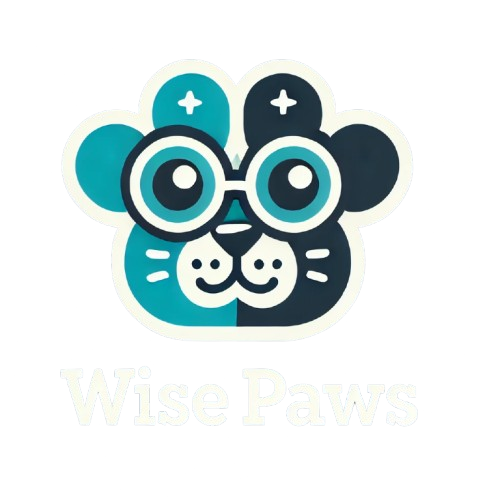
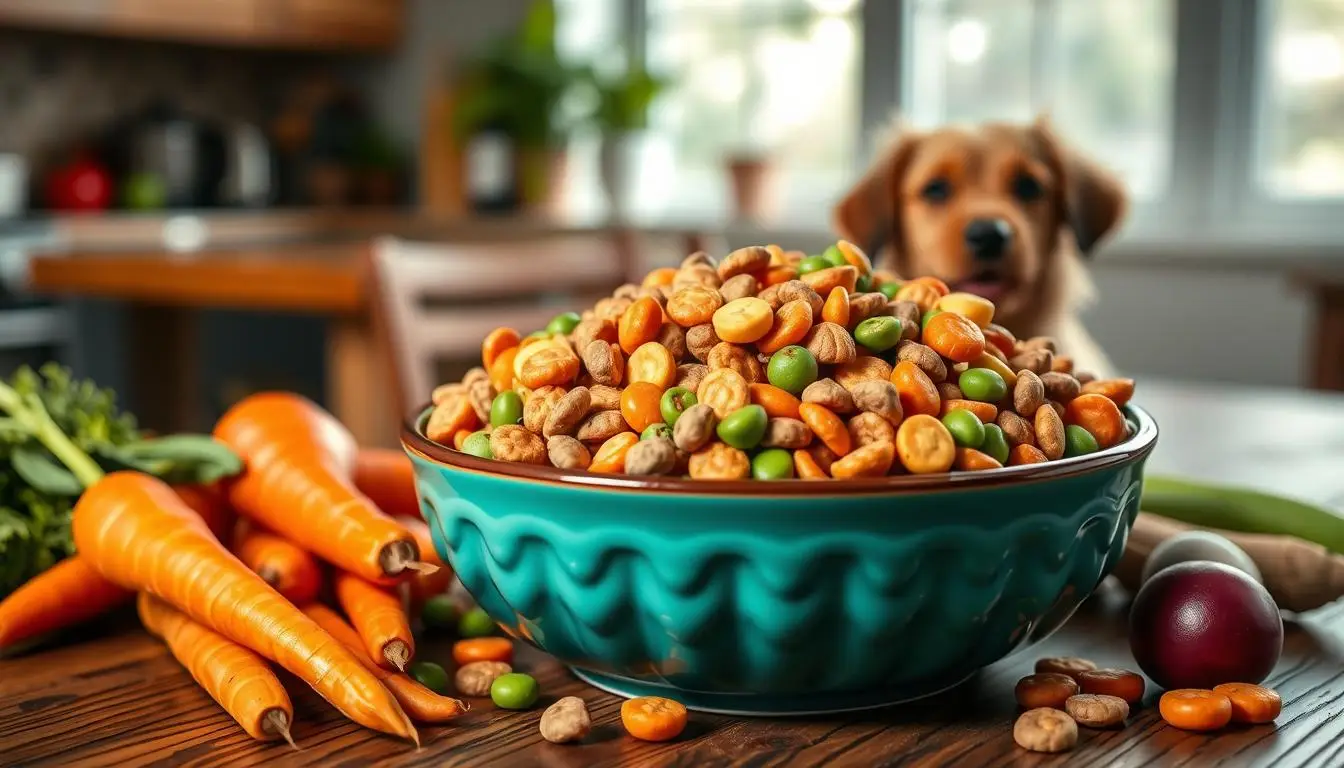



This is such a hot topic among dog owners, and I appreciate how you’ve broken down the pros and cons of grain-free dog food. In my experience, switching to a grain-free diet is often more about the dog’s individual needs than any one-size-fits-all solution. For instance, one of my dogs had persistent skin issues, and after working with our vet, we discovered a chicken allergy—not a grain allergy! Many grain-free foods also eliminate common proteins like chicken or beef, which might explain why they help in some cases.
That said, I’ve also been cautious with grain-free diets after hearing about the FDA’s research into the potential link with canine dilated cardiomyopathy (DCM). It’s a reminder that grain-free isn’t inherently healthier unless there’s a specific reason for it. I think the key takeaway is that balanced nutrition matters most, whether a food contains grains or not. It’s always a good idea to consult with a vet to determine what’s best for your dog’s unique needs.
Many online articles about dog food are biased or too promotional. This piece offers a fair look at grain-free diets’ pros and cons. My small terrier has always had a sensitive stomach. I’ve tried different grain-free foods, but the results were hit-or-miss. The part about protein sources really stood out to me. Not all proteins are the same. I appreciated how this article points out that grain-free isn’t always best for every dog. It’s all about finding the right food for each pup.
Thank you for your kind words Dan! We’re glad you found the article balanced and informative. You’re right, finding the perfect food for each dog can be tricky. Sensitive stomachs, like your terrier’s, make it even more challenging. It’s great that you’re looking at both grain content and protein sources. Finding the right one for your pup can take some trial and error.
We hope the article helps you find the best food for your terrier. Thank you for sharing your experience. Your insights are very valuable. 😊
Thank you for this informative content! I especially appreciate the emphasis on how different dogs have unique dietary needs; some may be sensitive to grains, while others benefit from having them in their diet. I’ve had labs who are very sensitive to foods. I’ve noticed they do better with fish, poultry, and with the grain.
Thank you for your kind words Shaelyn! We’re glad you found the content helpful. You’re right, every dog is different when it comes to food. It sounds like you’ve found the perfect diet for your labs. Fish and poultry are great for dogs with sensitivities. It’s awesome that grains have been good for your pups.
Thank you for taking time to read and also leaving a comment 😊
One of my biggest challenges is cutting through the marketing hype to figure out what’s truly best for my dog, Sadie. Grain-free diets often seem like the healthier choice, but the lack of solid scientific evidence, combined with the FDA’s warnings about potential heart risks, leaves me feeling unsure. I’d love to see more research and clearer guidelines from veterinarians to help us as pet owners make informed and confident decisions tailored to our dogs’ unique needs.
Hey Byron! we completely understand how overwhelming it can be to sift through all the marketing claims and find what’s truly best for Sadie. Grain-free diets are definitely a hot topic, and the FDA’s warnings about possible links to heart issues have left many pet owners feeling uncertain. Like you, we’d love to see more research and clear guidelines from experts to help navigate these decisions with confidence. In the meantime, consulting with a trusted veterinarian is always a great first step. They can assess Sadie’s unique needs and recommend a balanced diet tailored just for her.
Thank you for adding to this important discussion! We also appreciate you taking time to read our content 😊
As a long-time dog owner, I’ve experimented with different diets to find what works best for my furry friend. Grain-free dog food initially seemed like the perfect choice, offering potential benefits like improved digestion and a shinier coat. However, the ongoing discussions about its link to heart disease have made me cautious. While I appreciate the variety of high-quality ingredients in grain-free options, I now believe it’s essential to consider each dog’s unique needs and consult a vet before making any changes. In my experience, there’s no one-size-fits-all solution—balanced nutrition is key.
Thank you for sharing your experience Herman! 😊 it’s clear you’ve put a lot of thought and care into finding what works best for your dog. Grain-free diets do offer some great benefits for certain dogs, like improved digestion and coat health, but we agree that the ongoing discussions about potential heart health risks warrant caution. We also agree there’s no one-size-fits-all solution when it comes to pet nutrition. Consulting a vet and considering your dog’s unique needs are always the best steps toward ensuring they get the balanced diet they need to thrive!
Thank you so much for taking time out of your day today to read our content! 😊